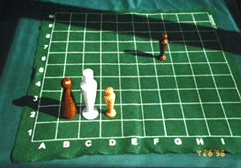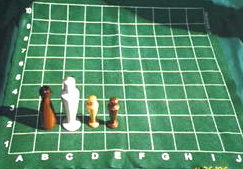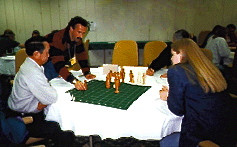Assessment is a collaborative process between the therapist and the client. The professional whose manner and methods sets the client at ease will successfully obtain crucial data with both comfort and efficiency. The Kvebæk Sculpture Tool and Technique fits the bill by assisting the client to “get to the heart of the matter” by showing how his life feels right now — who is in the client’s life and how close or distant the client pictures self to these others. The data obtained points the way to the goal the client is longing for, and provides important information to help chart the way toward the desired outcome.
Example of work with small child:
Here are actual examples of how a six-year old child sculpted “how it is now” and “how I want it to be” after his admission to a psychiatric hospital.
Which figure do you think he chose as himself, and which are his brother and his parents? What treatment options does this suggest with him and his parents?
——————————————————–
The Kvebæk instrument is “hands on” and user friendly. Dr. Wayne J. Ehrisman, an experienced psychologist and clinical professor, wrote the following, “As a psychologist with interests in personality assessment, I was impressed by the potential of the Kvebaek for use as a projective technique, with particular applications for psychodynamic and family systems models of assessment and treatment.” He added, “…particularly useful for young children, who … communicate through non-verbal symbolic play materials … equally useful for adults as a projective technique that goes beyond the usual verbal narrative form of communicating internalized family dynamics.”
————————————————–
Multi-family group work:
A practitioner working with dual diagnosis adolescents and parents reports
“I have been using my KST Toolkit in sessions with adults & teens
to get a sense of:
- family dynamics,
- communication between family members,
- desired changes in family relationships.
This therapist also reported using the Toolkit in a multi-family group:
The parents
- mapped out their families of origin
- what communication feels like between members,
- what the relationships look like between members,
- how each would like things to be different.
The teens chose figures to represent themselves and their family
- to show how they were seeing their family, and
- how they would like things to be different.
These group experiences led to families working together toward making some positive changes.
————————————————–
In the picture below, a lady who has recently moved from her single-family home to a community setting, shows her family members and new friends.
—————————————
Below, a school counselor sculpts a case.



